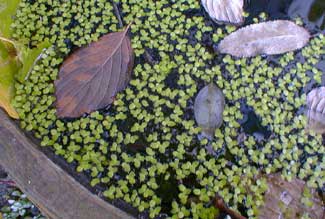
Duckweed in the Rainbarrel
Sundry species of duckweeds exist native throughout the globe. Lemna minor is the most common species in North America. It appears uninvited in garden ponds & indoor aquariums, reproducing like mad. Any attempt to get rid of it usually fails, as missing even one of the eency-weency fellows would be enough for it to get going again, plus you can't get the dust-small seeds. So one might as well appreciate the charming traits & usefulness of this ultra-miniature waterplant, & stop getting oneself in a dither over its arrival.
For all their tiny size & simple appearance, they're quite complex. Duckweeds are the world's smallest flowering plants, though the blooms are hardly noiceable without a magnifying glass, consisting of two white pollen-baring stamins & one even smaller pollen-receiving style. If magnified one will see the lemna blooms look like three little horns void of flower petals. The style has a blunt cupped tip.
Additionally, the pollinated style produces the smallest fruit of any plant in the world, just such a miniscule pod with one to five micro-seeds within. The pod is held aloft above the double-leaves where it dries out & bursts open dispersing seed. However, by & large, the reason it spreads so swiftly over the surface of the water is because the leaves themselves keep reproducing vegatively & exponentially, turning from one to a million wee plants in no time.
Sometimes the plants disappear in winter, but they haven't died back. If winters are cold enough, the duckweed sinks to the bottom, becomes dormant, then awakens when the ice has melted & rises again to the surface! Smart little duckies.
Each plant consists of two leaves that float on the surface dangling a single minute root in the water. Duckweed's closest relative is water lettuce (Pistia sp.), but they are also relatives of the aroids, such as jack-in-the-pulpits, though formerly it was believed they were related to orchids & palm trees.
It's very useful in nature, a high-protein plant that makes excellent food for fish, waterfowl, & wildlife. It has also proven useful to science for cloning & genetic experimentation & for assessing the health or pollution levels of watersheds & other natural environments.The European space program is experimenting with duckweed as a possible food resource for extended stays in outer space. It is already being used for organic sewage treatment & purification of agricultural wastewater. Duckweed grown on pools of sewage are not toxic & can be skimmed & processed as food for farmed fish or livestock, or it can be used as fertilizer mixed with soil.
Useful as it is, pond-keepers & aquarium hobbyists do betimes complain of it for getting in filters & if ignored eventually massing up thick enough & unappealing to block light in aquariums or harrass delicate waterlily cultivars in ponds. Yet a regular policy of skimming will keep it from becoming a burden, & in reality it can be as attractive on water surfaces as moss is on rocks, & it has enormous benefits even in the hobbyist context sufficient to counteract any griping.
For aquariums, it removes phosphates from the water with such facility that it keeps the water healthy for the animals living in the tank. Duckweed functions as the most natural of all biofilters turning impurities into its own leaves, including even heavy metals that could otherwise accumulate in tank water. Discarding excesses of duckweed rids the fishes' environment of uhealthful impurities, without subjecting fish to the shock of major water changes.
Furthermore, duckweed out-competes algae which can otherwise cloud water or cover the fronts of glass, which is vastly less attractive than having duckweed on the surface. Algae tends to thrive in conditions not correctly balanced for the health of higher aquatic plants & fish; duckweed acts to restore a balance beneficial to higher plants & to fish.
Plus, fish appreciate the protection from harsh overhead lighting. A thin "ceiling" of greenery makes the fish happier, encouraging breeding activity. Diffuse lighting is the best for showing off the colors of the fish. Not to mention that duckweed is a good food liked by goldfish, barbs, & other veggy-loving species.
As we have fish in the rain barrel, the duckweed can't be permitted to get thick, as we want to be able to see the small white "tuffy" minnows when they approach the surface. It is no burden at all to occasionally skim the surface. Because the skimmed duckweed makes such a good soil fertilizer, we need only spread it out on some little area of soil near a privileged plant or two.